#gm resources
Text

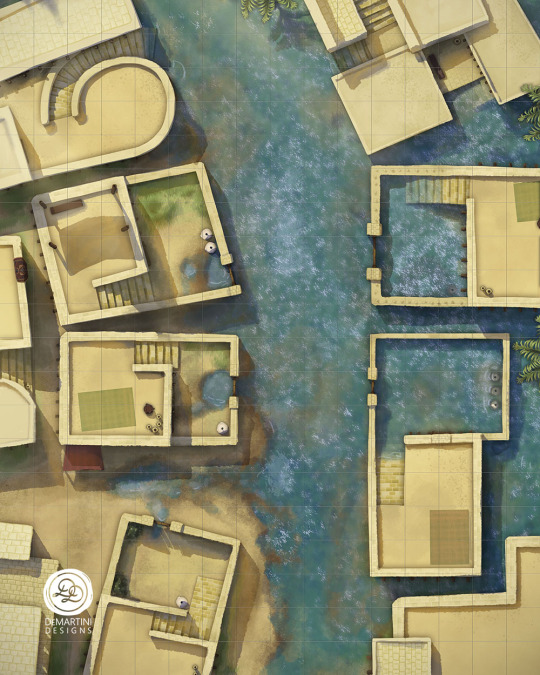
The sounds of daily life rise above mud-brick walled courtyards on either side of the street, leading eyes to rooftop gatherings under shaded canopies and down alleys to the nearby, verdant delta lands.
This map set can be found on Roll20 and more like it through the Interactive Map Directory on demartinidesigns.com
Help pick new map topics and receive early Roll20 and full res files.
| patreon.com/demartinidesigns |
87 notes
·
View notes
Text
So I've been DMing for around 6 years now, give or take, and quite a few of my players have asked me to share the consent and character building forms I send out to them before every campaign so they can use them in their own games. I figured I might as well share them here too in case anyone is looking for GM resources. It's mostly written with 5e in mind since that's what I play most often but it's pretty easy to adapt them for pretty much any system I've seen. You should be able to view everything with this link, but you'll need to create your own local copies to actually use the files:
(DO NOT share the forms from the master folder directly. I will purge any data that gets collected in there to protect the privacy of anyone responding since this is an openly shared folder)
If you guys have anything you think would make a good addition, either as an item on one of the forms, or as a general resource document etc. let me know and I'll add it or make something if it doesn't already exist in a useful format.
#dnd#ttrpgs#ttrpg community#dnd community#gm resources#dm resource#forever dm#idk how useful these will be#but they're here if you want them i guess
12 notes
·
View notes
Text

Come visit The Arvercim, a tavern that is super popular with wizards!
The first part of my new TTRPG The Arvercim [Compact Space - Fantasy #1]project is out today!
Inspired by toys like Polly Pocket, Compact Spaces are system-neutral locations GMs can include in their ttrpg campaigns!
Get it on Itch!
#ttrpg#tabletop rpgs#tabletop roleplaying#tabletop role playing game#polly pocket#playset#GM resources#DM resources#DND#dnd 5th edition#DM tips#GM#DM#ttrpg community
13 notes
·
View notes
Text


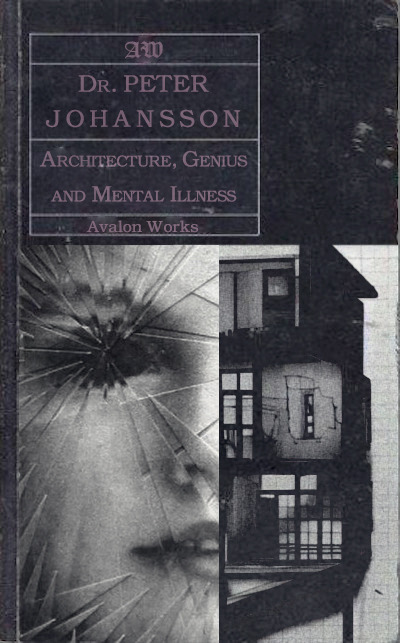
Once known, the horrors can't be put back into the books.
The covers I made for my players of IMPOSSIBLE LANDSCAPES. Photoshop.
#Delta Green#Delta Green: Impossible Landscapes#Impossible Landscapes#Handouts#Impossible Landscapes Spoilers#TTRPG#GM Resources#Tabletop Roleplay Games#Call of Cthulhu#TTRPG Art
6 notes
·
View notes
Text
Hey all, This is my first Tumblr post ever! I'm pretty new here, but I'm hoping to share some DM techniques, tools and tips and to make some new friends as well! Feel free to send a chat request (an ask[?]) if you're interested!
With that aside, on with the post!
Better and More Meaningful Random Encounters!
Random encounters are a staple of DnD, they are expected to be there during exploration as a way to make the world feel alive, to have it have an aura of adventure and danger, to eat up party resources and put pressure on the PCs to make interesting and important choices, and also as a way for a DM to reasonably 'stall' the party with a quick and easy situation.
Usually, it ends up something like this:
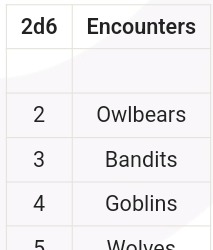
There's just one problem with most random encounter tables though, it's so easy for them to be GOSHDARN BORING! Especially for a newer DM.
Making them interesting becomes gambled improv on the DM's part if they're not used to it, and it's hard to keep track of the important factors that need to be kept in mind
Luckily, I ended up finding a great source for random encounters from 'Dungeon Masterpiece' on YouTube, and I integrated it into my own DMing. I figured that I'd share it here for any that want to work it into their own sessions as well!
After adjustment, a single table can account for multiple entire sessions of in-depth worldbuilding and fun without getting dull!
Sources:
Source 1 (Creating interesting Random Encounter Tables):
youtube
Source 2 (Making Random Encounters reflect your Worldbuilding):
youtube
There's 4 major methods we can use to improve the Random Encounter table
1. Make the table a straight 1dx roll.
2. Adding 'depth'.
3. Adding meaningful encounters.
4. Prerolling and/or Multirolling.
You can also check out the "Where to Start?" section for some direction to make getting it down and prepped all easy peasy!
1. Straight Roll:
Its enticing to go for 2d6 or the such in order to add non-linearity to the rolls, but these sorts of adjustments only end up making one or two encounters extremely likely and leave all others in the dust, it often ends up defeating it's own purpose of interesting randomness.
In the previous example, it was extremely likely to only get Wolves, Barbarians, Orcs, or Spiders, from a table of 12! A straight roll would serve us much better. The rare rolls are already rare enough as is!
Simply enough, adjusting the original example by replacing the 2d6 with 1d12, it'd become something more like this:
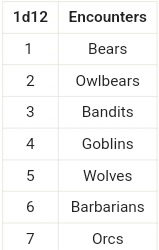
#2. Adding Depth:
We can add more columns in the encounter tables. These columns will represent different aspects about the encounters that we can roll on separately!
Usually it can be difficult as a DM to naturally come up with motives for the encounters, showcase the worldbuilding and have it all come together.
This setup can give you a solid guideline on how the creatures/people think (if any), and also sets up the overall area so that you get an idea of what events tend to occur there as a result of its occupants.
We want to add 3 more columns to the tables to convey different aspects of the encounter. Fill in these new columns corresponding to the expectations of each encounter.
We'll roll each of these and combine them, then we'll interpret them to make a robust, in-depth random encounter with truly unexpected results!
I recommend rolling alot of complete encounters at once and interpreting the context to the vast general area the party is travelling in.
i. Behaviour: How the creatures act. Are they friendly, scared, aggressive, curious, mischievous?
ii. Complication: Something behind the scenes in the encounter. Do they have sick young? Broken equipment? Are they starving?
iii. Significant Impact: This is a tick box, and will only be present under ONE of the rows. It will be rolled like the other columns, but ONLY once. It signifies which encounter is the Significant Encounter
The Significant Encounter will have its encounter's presence prominent amongst all the other random encounters in the area. There could be burn marks and carcasses from a rampant dragon, or a goblin raid leaving tracks moving through the area. Which is the most impactful of the different encounters?
Adding this to our previous example would expand it to:

Rolling this would give us things like:
Significant encounter: Owlbears

Note that the significant impact shows that the Owlbears are a massive problem in the area. Perhaps the Owlbears are agitated for an unknown reason, and are unnecessarily aggressive.
The significance of Owlbears gives us context to the second one as well! Perhaps the hunters raided an Owlbear den, and adopted an Owlbear cub from there as well.
There could be uneaten carcasses, ravaged trees, less wildlife, etc around these parts.
Note how much sheer CONTEXT these columns add to our encounters. It's invaluable!
3. Adding Meaningful Encounters
Usually random encounters tend to be rather mundane and very one-note.
There's usually some general wildlife and monsters, different disparate factions without any rhyme or reason, and maybe a general non-combat encounter or two, but these don't really tell us about the area or its surroundings at all by themselves.
Instead, we can add in wildlife and monster encounters specific to the biome, non-combat encounters, and encounters of nearby factions and/or settlements to the table, and we can even add environmental encounters in there as well.
Note that we're not tied down to 12 encounters, and can expand it ad infinitum according to our need of diversity in our encounters.
Just add in specification and connection, and suddenly the dominos all fall into place.
Lastly, we'll also be adding in 'DOUBLE TIME' which will let us roll on everything twice, and make it so it's a double encounter!
Thus, the table can instead be adjusted to:
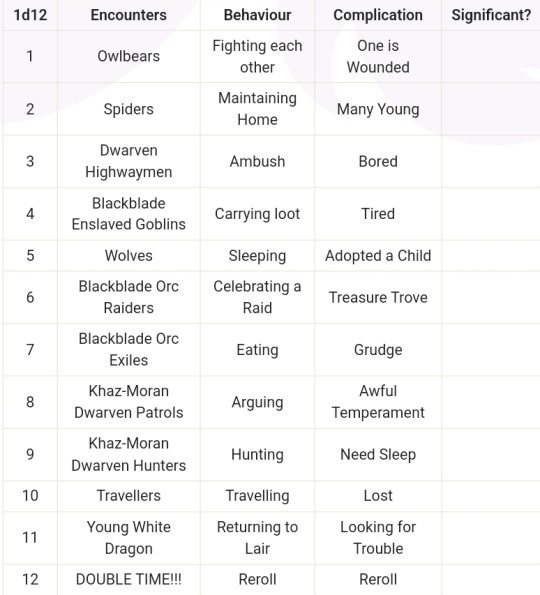
Note how each and everything has its relation in one way or another, but through the sheer variance, they remain truly random and novel.
4. Prerolling and/or Multirolling
Lastly and this is just something that I do, but that I found gamechanging. Be sure to pre-roll 5-7 encounters for each session, for the general area the players are going to be headed in.
Note that you don't need to really prep anything at all, just interpret all of them on a surface level as a buffer.
Also note that you don't need to use all of them if they're not needed. The foreshadowing and signs are worldbuilding and having secrets that the players don't unravel is just as useful as the ones that they do, perhaps even moreso. It adds depth and detail beyond the scope of what the party will encounter
It simply let's you get an idea of the connections between encounters, allows for foreshadowing, and acts as a deterrent to getting caught off guard.
Even if you roll mid-session, I recommend calling for a 5 minute break, rolling 5-7 encounters at the same time and interpreting them and their connections before resuming the session.
It WILL make a difference, trust me
Where to start?
It can be difficult getting inspiration or direction to get started in creating these random encounters, and sometimes you don't want to go through the hassle of thinking them up from nothing
For some great conceptual headstarts and examples for these tables, you can check out 'Worlds Without Number' and it's:
- Page 205 (Great general templates for encounters differentiated by broad creature types such as Beasts and Monsters, Sapient Monsters, and Humans)
- Pages 206-219 (For inspired locations to occasionally run rare encounters or groups of encounters in. This works best with flexible/discovered worldbuilding given the significance of some of these, and you also want to add these in sparingly to keep them significant)
- Pages 246-247 (These pages have great templates for the kinds of encounters and situation to be included in the tables, and it can be expanded vastly, and certain options can be selectively and repeatedly chosen to meet our needs. Mood works well as a complication.)
There might be other pages that are useful as well for these sorts of random encounters in the wilderness that I haven't come across yet. If so, give them a shout out and I'll be sure to add them in. It's worth checking it out in its entirety for some great tips!
Conclusion
Again, credit goes to Dungeon Masterpiece and Worlds Without Number for excellent adjustments. This has been quite long, but I hope you stuck around till the end.
Many a session have been made easy but complex ever since this was introduced and I hope that this helps you out as much as it helped me in my prep and improv!
Feel free to give any advice in formatting on Tumblr, or any feedback on the post itself. It really means a lot to me, thanks!
#dm tools#dungeons and dragons tips#dungeon master tips#dm advice#dm tips#ttrpg#dnd#Youtube#dnd resources#gm tips
58 notes
·
View notes
Text
that one clip of that one guy being a dom dm made me want to get into dnd/ttrpg btw
#now i don't understand much of it but i'd love to learn#any and all pointers or resources are much appreciated btw#ive watched the entirety of misfits and magic#and now im watching a crown of candy#i wanted to see the mechanics of how its all done so the gm style of aabria intrigued me and#i get why brennan is such a powerhouse as i get through acoc#(pls refrain from recommending how to watch d20 stuff because im already overwhelmed)#dimension 20#brennan lee mulligan#ttrpg
20 notes
·
View notes
Text
hoho! art thou making battle maps? fantasy world cartography, perchance?
forgotten adventures has +120 000 high resolution assets [11 GB] available to download for free on their website!
frequent user of dungeon draft? they have +30 000 free objects available on their starter pack as well!
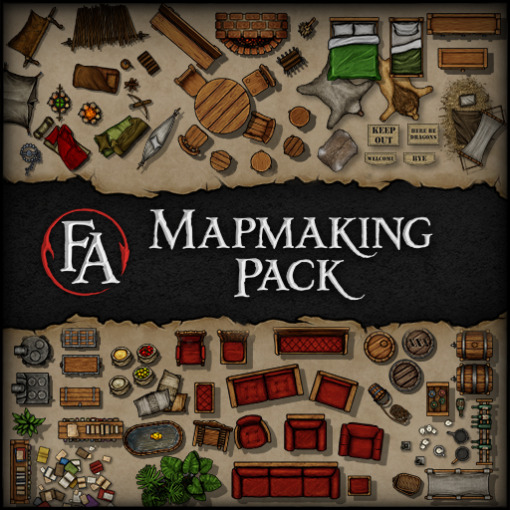
#websites#dnd#dm tools#tech tips#wizardblr#dnd maps#dnd resources#ttrpg#ttrpg community#pathfinder#worldbuilding#gm advice
8 notes
·
View notes
Note
what are your opinions on the NEWEST gustholomule delusion? ya know the true loves kiss one?
The fucking what
#i dont pay attention to other gm fans other than my mutuals idefk whats going on over there#im like hinding in a bunker avoiding the apocalypse until i have to get out and search for resources once a week
82 notes
·
View notes
Text

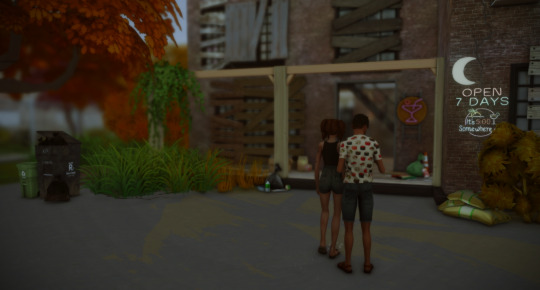
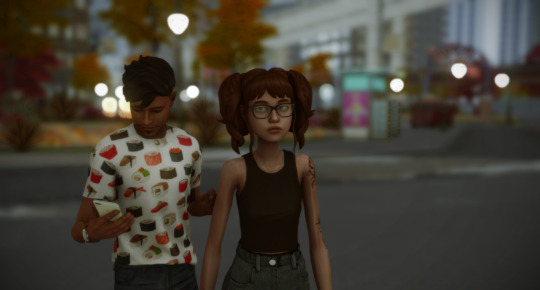

In late June, Ed and Stormy moved into the derelict Old Salt House bar, previously owned by his great aunt. He inherited it since there were no other surviving relatives.
They previously lived in a shithole studio apartment in Evergreen Harbor, so a little bit of fix-'er-up was acceptable. This was a lot more than a little bit. This was going to take literal years.
Stormy didn't mind a bit of mess, but Ed fainted because of a mouse caught in a trap. Honestly, he couldn't handle anything more intense than the dishes or sweeping. She had no idea why he thought the costs saved in doing it themselves would be worth it, but she knew better than to draw attention to this fact.
"How's it looking?"
"Haunted as fuck, get in before you get rained on."
#Stormy Nessa Jones#Edgar Isaac Orson#random legacy challenge#sims 4 legacy#Orson family#Gen 1: Orson#san myshuno#sims 4 gameplay#gshade preset: gm lithium#i downloaded this from the gallery#i'll do a resources page one of these days I promise
10 notes
·
View notes
Text
So You Want To: Make A RPG Character Portrait
And, Unfortunately, Lack Art Skills
Introduction
Like I said, I'm against commercial use of diffusion-based image generation, so please take notice and don't use the advice below in the process of creating commercial role-playing game supplements.
Let's start with the necessary tools: like I said, LAION's datasets are beyond useless - with the exception of the new SDXL, which is pretty much the only one first-party dataset for Stable Diffusion that works. So, in order to save time, you want a serviceable dataset: Dreamshaper, ICBINP, RPG, SDXL as a last resort. Most sites that host them tend to shake you down for money, so here are some recommendations:
Leonardo.AI: their free account grants you 150 points daily (non-cumulative) and allows you to use a lot of third-party datasets (including Dreamshaper, RPG and SDXL). The generator has some special sauce plugins running under the hood, meaning that your results will be noticeably better than if run on any other site or a local setup.
Playground AI: their free account allows you to use some interesting third-party datasets, but there's a lot of fine print of the shifty-as-fuck kind when it comes to quality of generated images.
Nightcafe: unfortunately, it only supports SDXL when it comes to worthwhile datasets, but a free account gives you 5 points every day if you log in and you start with 150, so it should be enough.
Of course, it's best to run a local setup, so if you have a gaming PC built in the last four or five years, and with a Nvidia video card, do so.
Writing Prompts
Two things you need to know about prompts in StableDiffusion: try not to go over 75 words and put the most important things you want first. I don't want to go into the technicalities, even if that's your kink, but that's how the thing works.
Of course monkeys on the internet tend to suffer from bouts of logorrhea while trying to describe what they want, and I warned about that before, so get to the point and don't be too specific. Stable Diffusion has problems with small details anyway.
For my artist imitation tests, I started by setting the style, like:
((fantasy art by Frank Frazetta)) of
((illustration by JC Leyendecker)) of
((portrait by Rembrandt)) of
((anime art by Akira Toriyama)) of
Double parentheses mean that Stable Diffusion has to pay extra attention to the phrase: every set of parentheses increases the weight of phrase by 1.1, so double parentheses means that the phrase is weighed at 1.1×1.1, and that's 1.21 if you don't have a calculator handy. Don't go above that because otherwise the results get spectacularly fucky (I canned the image with a hellishly distorted Maine Coon that showed up due to unfortunate wording, so I'll spare you that story - it's easy to guess what I asked for, though).
You can also try more generic descriptions of the style, like:
((woodcut portrait)) of
((renaissance portrait)) of
((vintage prison mugshot)) of
((kodachrome 400 photo)) of
((promotional movie still)) of
They still work and go off the rails less often than invoking a particular artist's style (for example, asking for Vermeer drives the generator bonkers).
Then, you follow with the base description of the character. Please keep in mind that some datasets are overly literal and if you ask for a "girl" you will most probably get a child as a result - try a "young woman" instead.
overweight 50 year old man with brown hair and large mustache
teen girl with long ((red hair))
asian woman with bob cut hair
muscular (bald) African man with goatee
man with shoulder length dark hair
Notice that in two cases, I put more emphasis on the hair style and color - just in case, but as I learned lately, this is often necessary. For example, when asking for "bald" without emphasis along with "portrait by leonardo da vinci" for the portrait of Sir Baldy Bald, I got eight different stages of receding hairline, two portraits of Matthew Mercer and two portraits of definitely bald guys. Not that I haven't repeatedly warned that diffusion-based image generation is a trainwreck most of the time.
Asking for a celebrity likeness at this stage is hella iffy, particularly when it comes to recently famous people. Like, you might not get a likeness of Jenna Ortega. Even asking for "young" version of old actors might get problematic when the generator starts to artificially de-age a more recent photo or doesn't find any reference at all.



For example: on the left, we have a genuine photo of Madonna from the 1980s. In the middle, I asked Leonardo.AI for "young Madonna" and it went off the rails. On the right, I changed the prompt to "1980s Madonna" and got something more realistic but still not entirely on the mark. It's typical - unless you're running an embedding or a LORA of a celebrity likeness on a local setup, it's gonna turn out genericized and/or distorted. Another example I can refer you to is Henry Cavill getting mashed together with Michał Żebrowski for a barely comprehensible reason.
Also, as I mentioned earlier, Stable Diffusion doesn't do little details well. Eye color usually parses, particularly if the face has a high enough resolution (meaning, it's more sure to work on close-ups in default 512px images and in high-res fixes). Scars, facial piercings and the like usually don't work, when they do it's a small miracle requiring very specific conditions (usually a resolution high enough to consider them a distinct object), and you might be better off omitting them entirely. Larger things like tattoos work, but in a very general way. Meaning, a general location and theme of tattoos should parse, but anything more specific will often send the entire thing off the rails and put stuff from the description as items elsewhere in the photo. Meaning, you'll ask for a "flames tattoo" and everything will be on fire. Oops.
Now, we should get the character dressed. My go-to syntax for that relies on the word "wearing":
wearing a red qipao dress
wearing black and silver scifi combat armor
wearing medieval noble's clothes
wearing round sunglasses and (black suit) with red shirt
wearing white tanktop and beige prison trousers
However, asking for two different clothing items in different colors often goes off the rails. Like I said in an earlier post, the generators often confuse the description, switching and omitting colors even if you put emphasis on the specific phrase. If you asked for a specific artist's style, you'll often have to put emphasis on the color anyway, because the default tends to go right over it. An example can be seen in the example of Vermeer's style going off the rails - despite the dress being very emphatically described as red, "painting by vermeer" overwrote it as blue anyway.
There's also the matter of the generator having weird concepts of things. For example, "armor" by itself defaults to a typical simple plate armor, and not even "leather armor" is going to convince it otherwise. Even "scifi armor" is not going to parse correctly 100% of the time, but a "combat armor" or, better "tactical combat armor" will usually swerve it into a modern plate carrier. Curiously, though, asking for a "space marine armor" will go for a Starcraft/Warhammer 40000 armored spacesuit, and a "mech suit" will most often go for a weird, angular robot suit (add "armor" to that if it doesn't but you want it to).
A generator is not supposed to draw anything it doesn't have info on. This means two things: omitting a part of clothing, like trousers or boots, will limit the framing to only what's described. In case of dresses, robes and similar long outfits, it will often frame the character tightly enough to draw only a part of it - particularly if you defined the style as "portrait", as that keyword tends to focus on the character's face. Another thing, if you haven't described the background yet, and you don't need to, the background will be left as some kind of blank - usually a nondescript splash of color. If you asked for a historical-styled portrait, the generator will infer a muted, neutral color from that, based on actual examples. Asking for "illustration" or "concept art" should default to white. With "photography" and similar keywords, all bets are off. For example, "prison mugshot" left to its own devices either went with a nondescript dark background or prison-related things like bars and wire mesh fences. Asking for a "cook" filled the background with a generic kitchen. "Bottle of beer" gravitated towards tables, pubs and dining rooms. "Anime art" with a "medieval" subject either left the background blank or went for stone walls, castles and the like.
If you want a specific background, though, keep it simple. Even one word can be enough, particularly if the generator infers the rest from the character description. For example "garden" background for an "asian woman wearing a qipao" will add stone lanterns, torii gates and pagoda-roofed pavilions as needed. "City ruins" background for a "scifi soldier" will be full of damaged skyscrapers. What you can specify is weather and time of day - for example, the young Madonna example above specifies "alleyway at night" as a background.
And finally, lighting and stuff. With everything I mentioned already, this just adds an extra polish, but has to be applied with caution. "For example, "Dramatic" or "cinematic" lighting is good if you're going for chiaroscuro in paintings or a cinematic look in photos (it tends to infer a bit of movie-like haze) - for example, it works fine if you're asking for Rembrandt or Caravaggio, but it's gonna ruin the prompt if you're going for da Vinci, for whom "soft lighting" is more appropriate. You can also describe the lighting more directly, like "bright sunlight", "sunset", "torchlight", "candlelight" and the like (as long as it doesn't logically contradict the soft/dramatic/cinematic description). You can also add general quality keywords here, like "worn" (to get a bit of distressing on vintage photos, for example), "detailed" (it's a bit of magical thinking, but it might influence the look of armor and interiors), "black and white", "desaturated", "faded" or "vivid colors" etc. "bokeh" will also work for photographic styles, as a shorthand for low depth of field with background light sources.
Also, do not copy negative prompts from the internet. Stable Diffusion can't parse the concept of correct or incorrect anatomy or any other common fuckups it makes. Instead, one overly-specific keyword can wreck an entire concept of anime-style drawing or heavy makeup. Start with a blank negative prompt and correct from there. Your perp in the mugshot has a hat you don't want? Add "hat" to the negative prompt. Explorer in the savannah is sitting on a gimpy pony? Add "horse" to the negative prompt. You can also rule out a specific eye color, hair color and general use of color that popped up ass outta nowhere (if you can't trace where the use of color blue comes from despite being absent from the positive prompt, you can add "blue" to negative prompt and the problem should go away).
The Numbers Game
I explained this one before: diffusion-based generators can have drastically different results depending on the number of steps in a generation process and the guidance factor that defines how closely the generator follows the prompt. Web-based generators, if they allow tinkering with that, often obscure the exact values with wording like "short", "medium" and "long" rendering time. No matter what, don't go below "medium" with anything.
Then, there's the matter of image proportions and resolution. Proportions, if you can tweak them, are usually typical: 3:2, 4:3, 16:9 and their vertical equivalents. If not, you get a square by default. From my experience, going for 2:3 or 3:4 proportions for portraits with the shorter size as close to default 512px as possible yields the best results, as a lot of input images that were portraits before being pounded into mathemagical fairy dust also had those proportions. Also, some web-based generators tend to obscure resolution as well, maybe with a tooltip specifying the rough dimensions (like Nightcafe's "medium" size being about 400px on the shorter side).
Practical Magic
Okay, so now you know what the knobs and levers do. You got the dictionary, the grammar, etcetera. Time to talk the talk.
Google searches for "fantasy art" and "sci fi art" are going to give you listicles naming some hotshots like Anato Finnstark, Simon Stalenhag and Bayard Wu, and my tests contain a who's who of the classics I first learned of in the Upper Triassic of mid-1990s.
If you're going for something a bit more down to Earth and classy, like creating a who's who of your dark fantasy local nobility, classical portraits are a good idea. Be advised, however, that if you go for a specific artist's look, you'll be wrestling with peculiarities too numerous to list. For example, Sir Baldy Bald as painted by da Vinci refused to lose his hair in most attempts, and women in armor as painted by Rembrandt tended to look much older and more masculine than intended - meaning all that had to be included in the negative prompt. Rembrandt, however, is good if you intend to create portraits of commoners, burghers and nobles in the same style.
Early 20th century or its analogue can swing two ways: either vintage photos or pulp artwork. For the latter, I need to run more extensive tests, but if you know who Norman Rockwell, J.C. Leyendecker or Earl Norem are, you know where to start.
#gm tips#dm tips#npc art#dnd character art#ttrpg#tabletop rpgs#ai art generation#ai image generation#ttrpg character art#character art#rpg resource#tabletop rpg
6 notes
·
View notes
Text

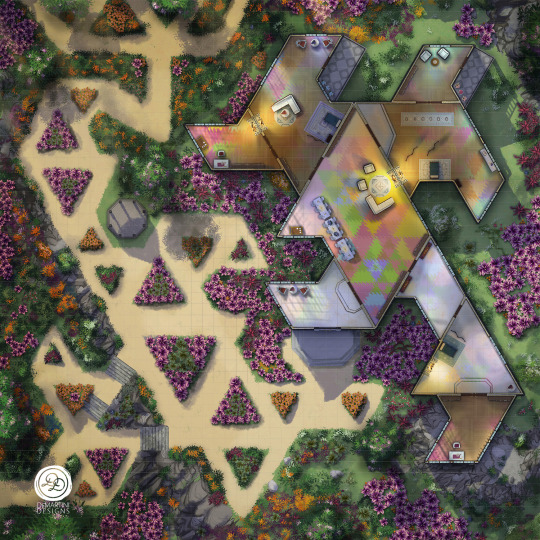


Nestled against the top of a cliff is a towering building of odd angles.
Giant paned windows gleam in the sun, gazing over the land below with its compound sight. No matter how lush and alive the scenery is around you, the palace waits, a silent hunter knowing the prey will come to it.
Did you know this map was built by my patrons last year during April Anniversary Month? This year we're doing it again! Polls are going on right now, so you can help build the map too.
This map set can be found on Roll20, my Patreon Store, and more like it through the Interactive Map Directory at demartinidesigns.com/map-directory/
Receive early Roll20 and full res files twice per month, for less than the price of one Roll20 listing. | patreon.com/demartinidesigns |
#battle maps#haunted forest#dnd battle maps#D&D battle maps#gm resources#dm resources#pathfinder battlemaps#mansion battlemaps
13 notes
·
View notes
Text
I sat down to prep for dnd like a normal DM, but I somehow ended up learning how to do more excel formulas to track rolls at the table for a campaign I’m not even DMing.
Anyway please enjoy my ttrpg nerdism reaching new levels:
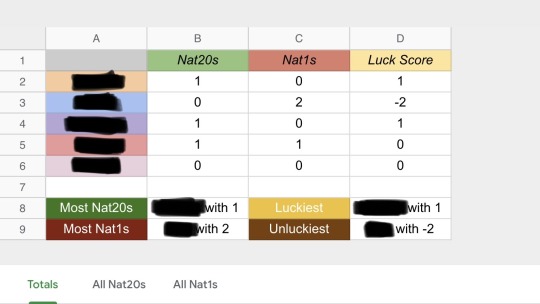
[ID: An excel sheet showing redacted names in rows. The columns are Nat twenties, Nat ones, and Luck Score. Below the data are the redacted name and score for each of the following: Most Nat twenties, Most Nat ones, Luckiest, and Unluckiest. End ID.]
The Luck Score is total Nat20s minus total Nat1s. This sheet is automatically linked to the per-session rolls sheets, shown below. So I never have to do math, and I love that for me.
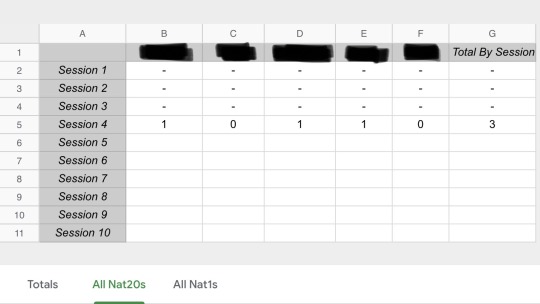
[ID: An excel sheet with rows reading Session 1 through Session 10. The columns are redacted names and a total of the type of roll (Nat twenties) per session. End ID.]
Now we have have DnD Wrapped, essentially! I love this sort of analysis and this was really easy - the hardest part for me will be remembering to track the rolls while we play!
#names probably don’t need to be redacted but I didn’t get their permission so it’s private just in case#nkab campaign#dnd#ttrpgs#excel sheet#if anyone wants the formulas I’ll provide them. not like I wrote any of them lol#dm stuff#gm stuff#dnd ref#dnd resources
6 notes
·
View notes
Text
5 interesting ways start your campaign
1) Ambush at Night - A really fun way to jump right into the action is to start with an attack of some kind. This gives your PC’s an immediate sense of danger to latch onto and drive that first session forward. Folks have time to settle into their characters through the simple problem solving of a combat.
Suggested Use: Use this in a navel campaign. Narrate your PC’s waking up from a dead sleep as cannon shots rip through their ship. You immediately have a tool to ramp up tension as you narrate the ship taking on more water. It also gives you some narrative questions to answer. Who is attacking you? What do they want from you? You get to capture the confusion of a battle where you don’t have all the information yet, which is mirrored by your players sudden entrance into the world
2) Mid Chase - This one comes from the latest season of Dimension 20. The very first episode opens with the PC’s rolling initiative. Their ship is already badly damaged, facing down a foe with overwhelming force. I like this approach as it provides a lot of the same benefits as starting with an ambush. Stakes are immediately clear, and your PC’s are given a unique situation to try and solve with their abilities.
Suggested Use: Start with the PC’s running down some major street in the city. They have a ton of loot, and a small army of guards in pursuit. They’ve just pulled off a heist but something went wrong right at the end. If you’d like, consider prompting them to banter about the failed heist. “You said this would be easy Flint!” “It was easy! until you triggered that alarm spell!” If you have players with strong roleplay chops, a chase is a really fun way for them to express their character choices through the action.
3) Common Goal, But Not Aligned Yet - This is a little harder to pull off, but when it works it works really well. As you work on your players backstory with them, subtly give them a reason to show up in a specific location or seek out a specific item. Don’t let them know that they are all after the same thing. Start the session and watch them slowly realize they all have the same goal, and let the character interactions fuel the drama.
Suggested Use: All your PC’s are reached out to individually by different factions, and asked to secure a magic item. Work with their backstory and make sure they would have a compelling reason to complete this task. Maybe they are hired by a crime lord who wants the item for power, or a group of scholars that wants to research the item. Whatever the reason, the hiring faction knows where the item is and needs you to get it. It could be in a dungeon and all the PC’s show up around the same time
If you have players who are really good at initiating their actions, then put the item in a silver briefcase in the possession of an NPC taking some form of public transit like a train. Now they all have to come up with a way of getting the briefcase from him, but still don’t know that everyone else is also after the same thing. As soon as 1 PC goes for the briefcase, many of your players will begin to catch on. Now you get to watch your players antics as they try and be the one with the McGuffin by the time the train stops.
4) Execution - So admittedly this is the opening to Skyrim. Cut out the 5 minute wagon ride of exposition though. Start with the PC’s on the chopping block, and create a scenario where they can escape. Maybe your PC’s are evil and deserve it, and a well timed prison break gives them their shot. Perhaps they have been wrongly accused of something and the first campaign quest becomes clearing their name.
Suggested Use: This is really fun when you want to create a world ruled by some form of dictator. This world is cruel, and the regime has twisted the rule of law to suit their own needs. Your PC”s immediately have a personal connection to the evil faction, and a reason to want to see them defeated. Those guys tried to kill them! Perhaps the local rebellion causes a prison break to gain some supporters. What's great is your PC’s \could all have different reasons for ending up there. Really use this as an opportunity to explore all the ways in which the regime is shitty and cruel.
5) Necromancy Gone Wrong - This one is a little specific, but it is super fun. Your PC’s awake in darkness. It’s cold here, damp. They stretch their arms and realize they are trapped in a stone box. Some Strength checks later, and they are sliding the lid off of a sarcophagus is an old tomb. They look in the reflection of an old shield and, in horror, realize they are an animated corpse.
Start your PC’s as undead deep within a tomb of legendary hero’s. The spell was botched and they retain their free will, but have no memory of who they were. You get to start with a reverse dungeon, as the PC’s work their way back to the surface. You have the immediate mystery's of who resurrected them, why and who were they in their past life.
4 notes
·
View notes
Text
Fletcher's Perch: A 5e Setting
Just east of the Carseil Mountains, on the edge of Gytham Wood, lies Fletcher’s Perch. In this small, primarily human town, farmers gather for the weekly market, children trek in for lessons, and adventurers and merchants stop by on their way always elsewhere. Fletcher’s Perch is a peaceful, prosperous town and has been for generations.
Fletcher's Perch is a setting I put together over this past summer. During its founding, the first family paid a terrible price to ensure their safety and prosperity. Now the promised period is coming to an end and the town will have to decide between an uncertain future and paying again. Meanwhile, a large werewolf population hides in the town and two feuding families are on the verge of war. Finally, unbeknownst to almost everyone, a massive danger slumbers underground and is on the verge of waking once more.
How to Use
Fletcher's Perch is a setting, not an adventure. This means GMs will need to do a bit of work deciding how to introduce and implement the various plots. The setting also contains suggestions for scaling difficulties and offers a few points of choice for a GM (most notably in the Imposter Son plot).
The various plots suggest a variety of approaches, including combat and deal-making, but do not require a certain tactic for success. I've also included stat blocks for any creature not in the basic rules and a few Inkarnate maps. I will admit, though, that I am no artist and so highly recommend GMs seek out their own maps.
This website includes an overview, a set of 12 rumors, details for 8 plots (some of which contain side quests), and bios for 84 characters.
All of the rumors can be true, but the GM will have to decide which will apply for their table and can either ignore the rest or introduce them as false leads.
The bios suggest some additional places where players can intervene on a more personal, less plotty level. For example, they can help Jenny Fox get feedback on her art or help Morys Vandal and Asa Murphy confess to each other. These are all incredibly optional, though. I've had some tables where players love getting into everyone's personal business and other tables where players just want to focus on the main objectives.
The site is written for GMs and so is full of spoilers.
I put this together for fun, so it is available completely for free.
Please let me know what you think!
Note: While I designed this for 5e, I think a lot of it is adaptable to other systems.
0 notes
Text
Free Voices for NPCs
Free Voices for NPCs
Following on from last week’s post about NPCs I thought I would give you a little freebie of voice ideas. As you can see they are split into 2 columns, sound of voice in the left and tone and pattern on the right.
These are really fun to mix and match, and if you feel so inclined you could roll a D20 for each column to see what you get!
Hope you find this helpful my little Dungeon…
View On WordPress
#accent#Characters#dungeon master#Dungeons and dragons#freebies#game master#newbie#NPCs#resources#rpg#tabletop games#tavern#teacup the GM#tips and tricks#tone of voice#voice references
0 notes
Text
Hi - we're on Tumblr now!
I'm sorry, who are you?
We're @sashasienna and @jonnywaistcoat, and we make tabletop RPGs as MacGuffin & Co.!
Tabletop what-nows?
Immersive storytelling games where you and your friends can dive into weird worlds, play fascinating characters and have harrowing adventures!
What, like Dungeons & Dragons?
*sigh* Yeah. Like Dungeons & Dragons
Ok, so what have you made?
Well, we've got a collection of system neutral micro-settings called Odd Jobs - it's eleven small and fascinating worlds to play games in, each with a campaign you can play through in a month. They're not designed for any particular system, so you can play them with whatever game you like!
Oh, and it won the 2022 UK Games Expo award for Best Adventure and was nominated for Ennie Product of the Year. Just sayin'.
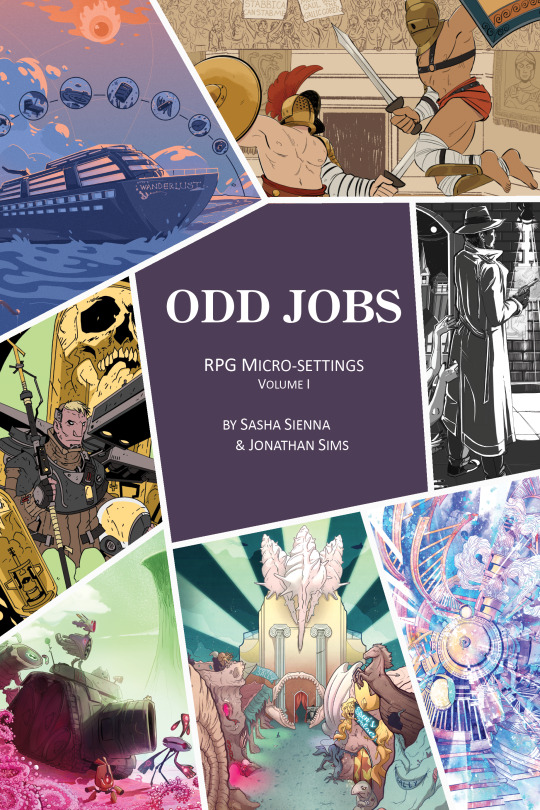
We've just released a tarot-themed magical river game called Upriver, Downriver with our dear friend Ella Watts, in which you play the crew of a ship sailing the Great River, either travelling upriver to the mythical Source with it's magic and revelation; or downriver towards the unending Sea with it's freedom and horizon.

We have KER-SPLAT! - a high-chaos, full nonsense cartoon RPG we wrote with Ross Barlow, where the players can't die and the GM can't stop them in a hilarious cascade of silly jokes. Also, not to brag, but this is the funniest RPG rulebook you'll ever read.

We also have smaller games, such as Zero Void - a no-prep one-shot zine game, where you play a bunch of desperate space criminals trying to escape a space station before the law arrives.
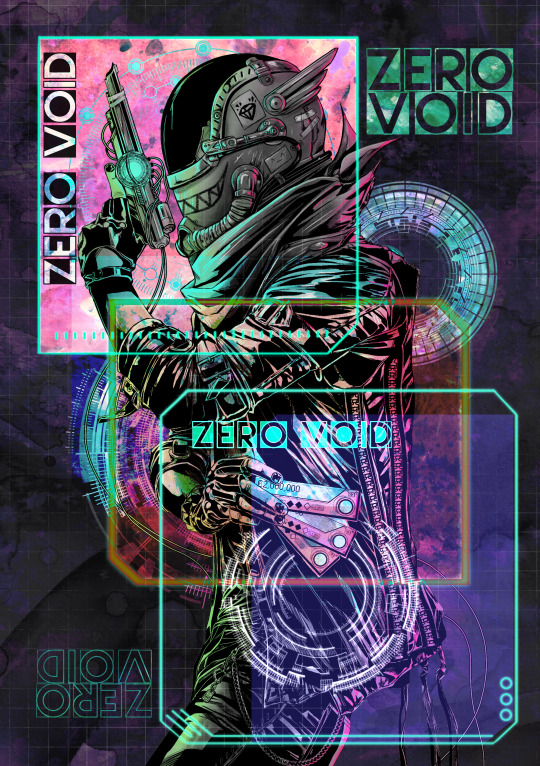
Is there any way to keep up with what you do?
Well, following our Tumblr is a great start. We also have a monthly mailing list you can sign up to from our website that will keep you updated on what we do.
We also have a Patreon.
What was that? You're mumbling!
Yeah, like all creators trying to eke out a living, we have a Patreon. If you sign up you get behind -the-scenes updates, small or prototype games, RPG resources, new micro-settings and our monthly TTRPG Gamesmasterclass, where we use our 35(!) combined years of GMing experience to help you run the best games ever.
But what if I want to see your faces?
Then I have great news! We stream boardgames and RPGs every Sunday at twitch.tv/macguffinandco! Jonny also streams videogames every Friday at twitch.tv/jonnywaistcoat, and Sasha steams their Jane Austen Bookclub every Monday at twitch.tv/sashasienna
Sounds cool - where can I find out more?
macguffinandcompany.com, baby!
Wait, so why are you on Tumblr?
Because social media is a nightmare hellscape and it's weirdly the chillest one left. We are on other social sites as well - you can follow us on Twitter, Instagram and Facebook - but this is our favourite.
#macguffin & co#macguffin and company#TTRPG#indie RPG#odd jobs#upriver downriver#ker-splat#zero void
1K notes
·
View notes